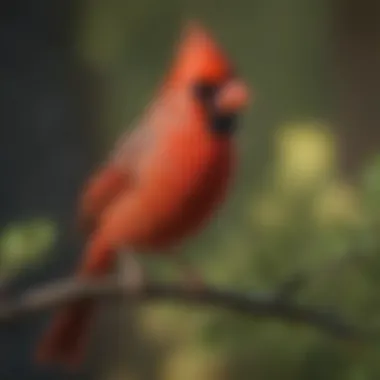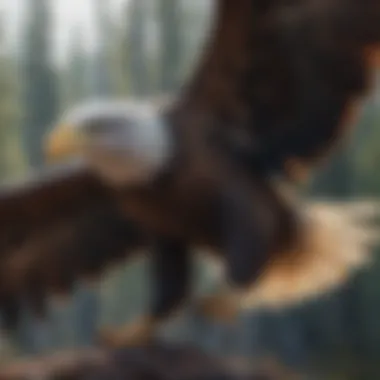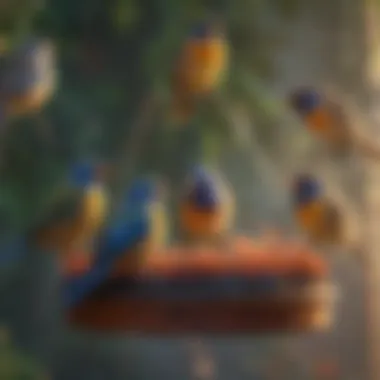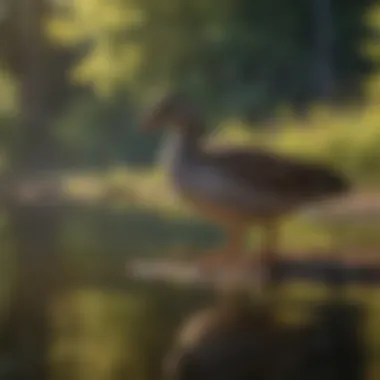Common North American Birds: A Detailed Exploration


Intro
North America is home to an astounding variety of bird species, with habitats ranging from the bustling urban environments to serene wetlands and dense forests. This guide aims to bring to life the common birds you might encounter in your backyard or local park. Understanding these creatures not only enriches the birdwatching experience but also deepens respect for the intricate ecosystems they inhabit. Through this exploration, readers will gain insights into avian diversity, tips for identification, and the pressing conservation issues many species face today.
Animal Overview
Common Name and Scientific Classification
North America boasts a colorful array of birds, and two notable examples include the American Robin (Turdus migratorius) and the Northern Cardinal (Cardinalis cardinalis). The American Robin, often seen hopping along lawns, has a distinctive orange breast and is considered a harbinger of spring in many regions. Conversely, the Northern Cardinal is known for its vivid red plumage in males and a more subtle hue in females. Both species hold significant cultural symbolism and are widely recognized by birders and casual observers alike.
Physical Characteristics
Birds in North America vary not only in color but also in size and shape. The American Crow (Corvus brachyrhynchos), for instance, is a large, black bird with a fan-shaped tail and a raucous call. In contrast, the tiny Ruby-throated Hummingbird (Archilochus colubris) is a mere three inches long, exhibiting iridescent feathers that shimmer in the light. These contrasting physical traits illustrate the diverse adaptations birds have developed to thrive in their environments.
Habitat and Distribution
From the arid deserts of the Southwest to the lush forests of the Northeast, each bird species occupies specific habitats. The European Starling (Sturnus vulgaris), originally introduced to North America, has adapted to urban surroundings and can often be found rummaging through trash in cities. On the other hand, the Great Blue Heron (Ardea herodias) prefers coastal marshes and wetlands, where it patiently hunts for fish. Understanding these habitats is crucial for birdwatchers who want to see various species in their natural settings.
Behavior and Social Structure
Communication Methods
Birds are known for their diverse array of sounds, ranging from melodic songs to sharp calls. The Eastern Whip-poor-will (Antrostomus vociferus), for instance, has a song that echoes through woodlands at dusk, while the typical chirps and whistles of a Chickadee (Poecile atricapillus) often signal nearby activity. The reasons behind these vocalizations can be quite complex, serving purposes from attracting mates to warning others of predators.
Social Hierarchies
Social structures among birds can be intricate. Some species, like American Goldfinches (Spinus tristis), display loose flocking behaviors, especially during migration. Conversely, other birds, such as Bald Eagles (Haliaeetus leucocephalus), establish more rigid hierarchies, often defending territories during breeding season. Observing these interactions can reveal much about their ecological roles and adaptive behaviors.
Mating and Reproductive Behavior
Courtship displays can be both fascinating and elaborate. For instance, the male Blue Jay (Cyanocitta cristata) often engages in acrobatics to impress potential mates. Nest building, which varies greatly among species, provides insight into environmental adaptations; some birds, like the Eastern Bluebird (Sialia sialis), prefer tree cavities while others might use open fields. The nest serves as both a shelter for eggs and a symbol of their reproductive success.
Conservation Status
Current Population Trends
Bird populations in North America are facing significant changes. Many species are in decline, driven by habitat loss, climate change, and urban development. For example, the Spotted Owl (Strix occidentalis) faces threats from logging in old-growth forests. Understanding these trends is vital not only for birdwatchers but for anyone interested in biodiversity.
Threats and Challenges
Human activities, pollution, and climate change have left their marks on bird populations. The migratory patterns of many species, including the Barn Swallow (Hirundo rustica), are increasingly disrupted, affecting their breeding success. Loss of habitat due to urbanization and agriculture creates a ripple effect in ecosystems, leading to reduced food sources and nesting areas.
Conservation Efforts and Success Stories
In response to these challenges, numerous conservation initiatives are in place. Organizations like the Audubon Society actively promote protection of habitats and develop programs to educate the public. One notable success story is the recovery of the Peregrine Falcon (Falco peregrinus), which was removed from the endangered species list thanks to concerted conservation efforts.
“The best way to birdwatch is not just to follow the birds but to watch the world around you.”
By understanding the critical aspects of these common North American birds—from their behavior to their conservation status—readers can heighten their appreciation and contribute to ongoing efforts to protect these fascinating species.
Prologue to North American Birdlife
Birds, those astonishing creatures of the skies, are some of the most familiar wildlife we encounter daily. From the bright chirping of sparrows in our backyards to the majestic silhouette of a soaring eagle, the diversity of avian life in North America is nothing short of remarkable. This introduction aims to set the stage for understanding not just what species inhabit this vast continent, but also the significance they hold in our ecosystems and daily lives.
The importance of North American birdlife transcends simple beauty. These birds play critical roles in maintaining the health of their habitats. Their presence and behaviors can indicate the well-being of the environment, thus serving as vital indicators of ecological balance. For instance, the thriving population of a certain songbird may suggest a healthy food web and less pollution in its area, while a decline in its numbers could signal looming environmental troubles.
Birds assist in various crucial ecological functions:
- Pollination: Many birds are not only seed dispersers but also play a role in pollinating numerous plants. Hummingbirds, for example, have specialized tongues that allow them to sip nectar from flowers, thereby helping these plants reproduce.
- Seed Dispersal: Birds often eat fruits and berries and, in turn, spread the seeds through their droppings. This natural process can lead to increased plant growth and habitat expansion.
- Pest Control: Certain bird species feed on insects, helping to maintain the balance in the food chain and limit pest outbreaks.
Exploring the vast array of species allows us to appreciate the nuanced relationships that exist between birds, their environment, and us. Not only do they enhance our landscape visually and audibly, but they also function as an integral part of the ecosystem. Observing them encourages us to think critically about biodiversity and conservation efforts.
As we delve into this guide, it is essential to consider the richness of habitats across North America—from coastal wetlands and mountain ranges to urban parks. Each setting fosters unique bird species with specialized adaptations that enable them to thrive. In a nutshell, understanding North American birdlife isn't just about identification; it's a journey into the intricate web of life that underscores our planet's health.
"Birds are indicators of the earth's health and remind us of the fragile connections among all living things."
Through this exploration, we will gain insights into identifying common birds, understanding their roles in ecosystems, and the importance of preserving their habitats, ultimately fostering a deeper appreciation for the avian world that surrounds us.


The Importance of Birds in Ecosystems
Birds may often be seen as mere eye candy flitting about the skies or chirping from treetops, but their role in the ecosystem is profound and multifaceted. These feathered creatures contribute to ecosystem health in ways that touch every aspect of nature. From pest control to plant reproduction, birds are integral players in the grand theatre of our environment.
Role in Pollination
While many may think of bees and butterflies as the frontline pollinators, birds like hummingbirds and certain species of finches also play a significant part. Hummingbirds, for instance, have specialized bills that allow them to extract nectar from tubular flowers. In the process, they gather pollen on their bodies and transfer it between blossoms. This interaction is not just a happy coincidence; it's a vital aspect of plant reproduction. The more diverse the plant life, the more healthy an ecosystem becomes.
Notably, birds such as the Scarlet Tanager and the Blue Jay are often seen hopping from tree to tree, helping to pollinate while also foraging for food. Their movements contribute to genetic diversity in plants, ensuring a resilient ecosystem.
Seed Dispersal Mechanisms
When it comes to spreading seeds, birds are some of the most effective agents of dispersal. Many birds consume fruits and berries, such as those from serviceberry or elderberry bushes. After digestion, seeds are often excreted at a distance from the parent plant, alongside nutrient-rich guano, which promotes germination. This process aids not only in the propagation of species but also in creating patches of biodiversity across varying landscapes.
Birds have different preferences for certain types of seeds, which means that the results of their eating habits can lead to varied habitats. For example, larger birds like the American Robin may transport larger seeds, contributing to the emergence of new shrubs and trees in areas where they haven’t thrived before.
Indicators of Environmental Health
Bird populations are remarkably sensitive to changes in their environment. As such, they serve as important indicators of ecological well-being. A sudden decline in local bird species can be an early warning sign of pollution, habitat destruction, or disease. For instance, an increase in lead poisoning cases among waterfowl often signals deteriorating health in aquatic ecosystems.
Researchers frequently monitor bird populations to gauge the overall health of ecosystems. The presence of specific species can indicate a balanced habitat, while the lack thereof raises red flags. For instance, an abundance of songbirds in an area usually indicates a healthy, productive environment rich in resources.
"Birds serve as the canaries in the coal mine, alerting us to shifts in environmental popularity and health. Without their presence, we may be blind to the changes lurking beneath the surface."
Common Bird Species Overview
The common bird species of North America serve as a reflection of the continent’s rich ecosystems. Each species is like a piece of a puzzle, contributing to the larger picture of ecological balance and diversity. Understanding these birds— from their unique traits to their varying behaviors—helps not only in identifying them but also doesn’t hurt in appreciating their role in nature. As we delve into these avian representatives, readers will glean the vital connections within our ecosystems, making birdwatching a higher purpose and not just a leisure activity.
Songbirds
Warblers and Their Habitats
Warblers are often considered the band of the woods, bringing energy to the forests and shrublands of North America. Their habitats typically range from dense forests to wetlands, showcasing their adaptability. A key characteristic of warblers is their vibrant plumage; different species flaunt unique color patterns which are often a delight to birdwatchers.
One notable aspect of warblers is their migratory behavior. These small but mighty creatures migrate vast distances between breeding and wintering grounds. This ability aids in maintaining the health of various ecosystems as they help with insect control and seed dispersion. However, they face significant threats from habitat loss, which makes understanding their habitats crucial for conservation efforts.
Thrushes and Their Songs
Thrushes, renowned for their melodious songs, are the poets of the bird world. Their songs fill the air with sweet symphonies, particularly during the spring months when they court potential mates. This songbird family, with its varied tones and patterns, significanty enriches the soundscape of North America's natural spaces.
A remarkable aspect of thrushes is their diet, which consists mainly of insects and berries, depending on availability. This dietary flexibility has kept them alive through changing seasons. Their adaptability to different habitats, from woodlands to urban parks, makes them a popular subject for study, as understanding their behaviors can lead to insights into environmental health. Yet, like many birds, thrushes struggle with increasing predation from domestic cats.
Finches and Their Color Variations
Finches, with their striking color variations, present an array of hues that dazzle birdwatchers. Often found in gardens and open fields, these birds exhibit a variety of color patterns depending on their species and age. The vibrant red of a male House Finch, for instance, stands in stark contrast to the earthy tones of the females.
What makes finches particularly interesting is their adaptive beaks, which allow them to crack open seeds efficiently. This specialization not only aids in their survival but also marks them as an integral part of seed dispersal in their ecosystems. Such adaptability makes finches a beneficial focus within this article, particularly when discussing behavioral changes in response to environmental factors. However, their dependence on specific food sources means that habitat degradation poses a serious risk.
Birds of Prey
Eagles and Their Hunting Skills
Eagles are often lauded as symbols of strength and freedom, possessing incredible hunting abilities that make them apex predators in their environments. With keen eyesight and powerful talons, they dominate in various habitats, from mountains to coastal areas. Eagles rely on their sharp vision to spot prey from distances exceeding a mile.
The adaptability of eagles to different environments only enhances their catch rate, making them a fascinating subject in the avian world. Their role in maintaining the balance of ecosystems by controlling populations of smaller animals cannot be overstated. Nonetheless, they face challenges from pesticides and habitat destruction that put their survival at risk.
Hawks: Masters of the Sky
Hawks are known for their remarkable flight capabilities. These birds posses agility and speed, which they use to hunt small mammals and birds, serving as critical control agents in their ecosystems. Their distinctive silhouette against the sky creates an image of grace and power.
Hawks also showcase territorial behaviors. Many hawk species, like the Red-tailed Hawk, perform aerial displays to establish dominance over their breeding grounds. Their adaptability allows them to thrive in varied environments, from deserts to urban areas. Nevertheless, hawks, like their eagle cousins, are at risk from habitat disruption and hunting pressures.
Owls: Nocturnal Predators
Owls have fascinated humanity for centuries, mainly due to their mysterious nocturnal habits. With their unique adaptations, such as silent flight and excellent night vision, they are efficient hunters, primarily preying on small mammals and insects. Their distinct calls often fill the night air, creating an atmosphere that’s both eerie and captivating.
Owls play a critical role in the ecology, helping maintain small mammal populations. Their specialized hunting techniques allow them to excel in low-light conditions, providing a stark contrast to their daytime counterparts. While they are often viewed as symbols of wisdom, owls face challenges, particularly from habitat loss and climate change, affecting their populations.


Waterfowl
Ducks: Diversity and Adaptation
Ducks represent a versatile group of birds, showcasing incredible diversity in their appearances and behavior. Found in lakes, rivers, and marshes across North America, ducks have adapted to a variety of habitats, which allows them to thrive in multiple ecosystems.
Their various adaptations include diverse feeding techniques, from diving for food to dabbling on the water's surface. This adaptability makes them a popular group among birdwatchers and enthusiasts. However, water pollution and habitat loss pose significant threats to their populations and ensure that ongoing study and conservation efforts are critical.
Geese: Social Behavior
Geese are social creatures, often seen in flocks either flying in V-formation or grazing in fields. They are highly social and mate for life, sharing the responsibilities of parenting, which can create strong family structures. This social behavior enhances their survival in landscapes where predators lurk.
While geese often symbolize loyalty and family, they can also become pests in recreational areas due to their sometimes overwhelming populations. Yet, understanding their complex social interactions offers insight into behaviors that benefit their survival and can enhance conservation strategies.
Swans: Elegance on Water
Swans, often associated with beauty and elegance, glide across waters with grace. Their long necks and stunning plumage make them a subject of admiration in various cultures. Swans are known to mate for life and often engage in elaborate courtship displays, reinforcing their significance in discussions of family and bonding among birds.
These magnificent birds encourage conservation efforts due to their captivating presence in natural settings. However, swans are also susceptible to habitat degradation, pollution, and changes in water quality. Understanding their needs is vital for effective conservation strategies and maintaining the beauty of North America's waterways.
Birdwatching Techniques and Tips
Birdwatching is more than just a quiet pastime; it offers a window into the intricate lives of avian species. This section digs into the essential techniques and tips that can elevate your birdwatching experience. Whether you've got seasoned binoculars hung around your neck or are just embarking on your first excursion, understanding the nuances of this hobby can lead to more profound insights into the behaviors and habitats of North America's feathered inhabitants.
Choosing the Right Equipment
Binoculars: A Guide to Selection
Selecting the right binoculars is like picking the right lens through which to view the world. Not all binoculars are created equal; different features cater to various birdwatching needs. A key characteristic is magnification, expressed in numbers such as 8x42. This implies that objects viewed are eight times closer. Many birders prefer this, as it strikes a balance between field of view and clarity.
While small, compact binoculars are lightweight and easy to carry, they may not provide the same clarity at longer distances. On the flip side, larger models can be heavy and cumbersome, impacting mobility during those long hikes through nature. When you're sitting quietly in the brush waiting for that elusive warbler to flit by, every ounce counts.
Cameras for Bird Photography
In the era of social media and instant sharing, capturing the beauty of birds has become a sought-after skill. A vital component for this is a good camera. DSLRs or mirrorless cameras with telephoto lenses are often recommended. Their versatility allows for snapping quick shots even under challenging lighting conditions. A highlight of modern bird photography cameras is their rapid autofocus feature. This helps capture moving subjects without the frustration of blurry images. However, investing in high-quality lenses can significantly raise the cost, so weighing your budget carefully is essential.
Field Guides: Importance of Knowledge
When it comes to identifying birds, field guides are invaluable. These resources provide detailed descriptions, illustrations, and specific field marks that assist birdwatchers in making accurate identifications. The beauty of field guides lies in their ability to demystify the complexities of birdwatching; a beginner can flip through the pages and spot the striking differences between a chickadee and a sparrow.
Many guides also include helpful diagrams about calls and behaviors, enhancing understanding and appreciation. However, it’s important to note, that not all guides are equally comprehensive. Choosing one that focuses on North American species specifically can bolster your overall birdwatching experience.
Optimal Locations for Birdwatching
Local Parks and Nature Reserves
Local parks and nature reserves are often overlooked but deserve their time in the spotlight. They act as sanctuaries for birds and are often well-maintained, providing rich habitats for diverse species. A key feature of these areas is accessibility — families and novice birdwatchers can easily visit without trekking far into the wilderness. However, because they are frequented by people, some birds may avoid these spots during busy times. Understanding peak hours for certain species can lead to a more fruitful experience. Keep in mind that every park has its character; what thrives in one might not be present in another.
Rivers, Lakes, and Wetlands
Water bodies like rivers, lakes, and wetlands are life-giving ecosystems for many birds. Here, you can catch sight of migratory waterfowl, wading birds, and plenty of songbirds that thrive in these lush environments. The unique feature of these areas is their biodiversity; the mix of aquatic and terrestrial habitats creates numerous niches.
Nevertheless, some of these landscapes can be challenging to navigate. Wet, muddy shores require sturdy footwear, and not all viewing spots will afford clear sights. Bearing that in mind, planning your route can enhance your experience significantly.
Urban Areas: Surprising Diversity
Surprisingly, urban areas are another hot spot for birdwatching. Parks and green spaces amid city landscapes offer refuge for many species. The adaptability of birds, like pigeons or sparrows, enables them to thrive even in bustling settings. A vital aspect of urban birdwatching is learning to tune into the nuances of the environment.
Of course, the downside can come from noise and human activity; many birds might steer clear of heavily trafficked locations. Still, with patience and the right mindset, urban birding can unveil a hidden avian paradise right outside your window.
Behavioral Observations
Understanding Territoriality
Birds are notoriously territorial, especially during breeding season. Understanding this behavior is a linchpin for birdwatchers since it dictates where birds will likely be found. Key characteristics of territoriality include vocal displays and physical posturing, often serving as warnings to intruders. The benefit of grasping this concept is twofold; not only does it enhance your chances of spotting those birds, but it also lends insight into their social structures, which can be fascinating. However, time of year and the specific bird species can influence territorial behaviors greatly.
Mating Rituals and Courtship
Diving into mating rituals unveils another layer of bird behavior that can be enchanting to observe. From elaborate dances to striking displays of color, male birds often go to great lengths to attract females. These rituals can vary dramatically by species; a peacock's tail isn’t just for show, it’s a crucial aspect of courtship.
For birdwatchers, understanding these rituals allows for deeper engagement during the observation experience. The flip side is that mating displays often occur at specific times, which may require patience or timing your outings correctly.
Feeding Habits and Diet Variability
Every bird species has a unique set of feeding habits, revealing a lot about their roles in local ecosystems. These can range from specialized feeders, such as nectar-eating hummingbirds, to the generalist feeders like crows, which have diverse diets.
Knowing what attracts certain birds, along with where and how they feed, can help birdwatchers set sights on particular species. Conversely, some feeding habits can make certain birds harder to spot; evasive scavengers, for example, tend to stay hidden.
Birdwatching enriches one's understanding of nature. It transforms everyday environments into vibrant displays of avian life.


Finding your rhythm, understanding the landscape, and arming yourself with the right equipment can truly transform every outing into an enlightening journey. As knowledge of these key elements evolves, so does the placeholder for wonder within each observation.
Keep that bird book close and let the adventure take flight.
Conservation of North American Birds
Conservation of birds has become a pressing issue in recent years, drawing attention from naturalists, scientists, and everyday citizens alike. As environmental stewards, recognizing the significance of avian populations is crucial. Birds play an integral role in various ecosystems, as they maintain balance through behaviors like pollination and pest control. Thus, safeguarding their habitats isn't just about saving a single species; it’s about preserving whole ecosystems that we rely on as human beings.
Threats to Bird Populations
Understanding the threats that birds face is the first step toward effective conservation. Several factors threaten their populations across North America, including habitat loss, climate fluctuations, and pollution.
Habitat Loss and Fragmentation
Habitat loss, often due to urban development, agricultural expansion, and deforestation, poses a substantial risk. Birds depend on specific environments to breed, feed, and shelter. As these areas dwindle, birds find themselves squeezed into smaller and sometimes less hospitable spaces.
The potential danger lies in fragmentation—this occurs when large habitats are broken up into smaller sections. When birds lose direct access to their sanctuary, vital resources become scarce. For example, a forest once teeming with life may become a disjointed series of patches; this limits migration routes and disrupts breeding.
Climate Change Effects
The impact of climate change extends beyond just rising temperatures; it disrupts the delicate synchrony between species and their environment. Changes in weather patterns influence food availability, nesting timing, and migratory routes. For instance, some birds may arrive at their breeding grounds too late, missing the peak of insect hatches essential for feeding their young.
Moreover, migratory birds are at risk when climate change alters their traditional pathways. The unpredictable nature of these changes can leave certain migratory birds struggling to find suitable habitats each year.
Pollution and Its Impact
Pollution wreaks havoc on bird populations in countless ways. From pesticides that poison food sources to plastic waste that birds ingest, the consequences can be dire. For certain species, exposure to harmful chemicals may lead to reproductive failures or dramatic population declines. For instance, the infamous DDT pesticide significantly impacted raptor populations due to thin-shelled eggs.
Increasing awareness of how pollutants affect avian health is essential for launching successful conservation strategies. By making connections between human activity and bird survival, communities can mobilize to tackle pollution at its source.
Successful Conservation Initiatives
Despite the many threats birds face, there are promising conservation initiatives that demonstrate positive outcomes. These efforts often rely on careful planning and collaboration among different sectors of society.
Protected Areas and Reserves
Creating protected areas is a foremost conservation strategy. These zones are dedicated to preserving biodiversity and providing sanctuary for vulnerable species. They help maintain large, uninterrupted habitats that are essential for wildlife.
Many reserves focus on protecting key ecosystems, such as wetlands, forests, and grasslands, recognizing their significance to bird populations. These places often become hotspots for birdwatchers, which further raises awareness of conservation issues and encourages visitors to become involved.
Nongovernmental Organizations' Roles
Nongovernmental organizations (NGOs) play a pivotal role in conservation, often brididing the gap between policy, community engagement, and active conservation efforts. With partnerships formed across sectors, NGOs initiate programs that monitor bird populations, implement habitat restoration projects, and educate the public on avian conservation.
Their influence extends to policymaking, helping to advocate for legislations that protect bird species at risk due to various threats. Such initiatives foster strong alliances among stakeholders crucial for achieving long-term conservation goals.
Community Engagement in Conservation
One of the most powerful methods for enhancing conservation efforts lies in community engagement. When local people see their natural surroundings as valuable, they often become passionate advocates for protection and restoration.
Efforts like citizen science projects or local bird counts allow people to engage directly in data collection and monitoring. This sense of ownership boosts awareness of local bird populations, making communities more likely to take initiatives against threats like pollution or habitat destruction.
Conservation of North American birds thus involves a multifaceted approach. By addressing threats and fostering proactive initiatives, society can work towards preserving the diversity of bird species and, in turn, the health of entire ecosystems.
Epilogue: Celebrating Avian Diversity
As we wrap up this exploration of North American birds, it becomes abundantly clear that celebrating avian diversity is not merely a whimsical notion but a fundamental pillar in understanding our natural world. Each bird we observe, whether it's the vibrant plumage of the cardinal or the elegant glide of a hawk, plays a crucial role in the tapestry of our ecosystems.
The Significance of Avian Diversity
Birds are often seen as indicators of the environment's health; their presence and behaviors give us vital clues about the conditions of their habitats. From the high-pitched tunes of songbirds brightening up a forest morning to the silent watchfulness of owls at dusk, these creatures contribute to the symphony of life. Their contributions to pollination, seed dispersal, and even pest control can hardly be understated.
"Birds are the living links between the earth and the sky, transgressing boundaries and providing insights into ecological relationships."
Benefits of Celebrating Avian Diversity
- Biodiversity Boost: By understanding various species, we learn how to protect their habitats, ultimately fostering a healthier environment for all life forms.
- Cultural Connections: Birds often hold cultural significance, inspiring art, music, and folklore. They remind us of nature's beauty and the countless stories it offers.
- Ecotourism Opportunities: Birdwatching promotes ecotourism, encouraging local economies while ensuring species conservation.
Considerations Going Forward
While it is essential to appreciate the diversity around us, we must also remain vigilant. Habitat loss, climate change, and pollution pose substantial threats. As families, veterinarians, and wildlife biologists, we all carry responsibilities.
In nurturing a love and understanding for birds, we equip ourselves not just to cherish them but also to work towards a future where they thrive. Each bird we watch, every call we hear, enriches our experience and strengthens our connection to nature. The avian world beckons us to participate in its preservation and celebration, reinforcing the idea that every species—no matter how small—plays a part in the grand scheme of life.
Let’s move forward with a commitment to preserving this avian diversity, acknowledging its importance not just for ourselves, but for generations to come.







